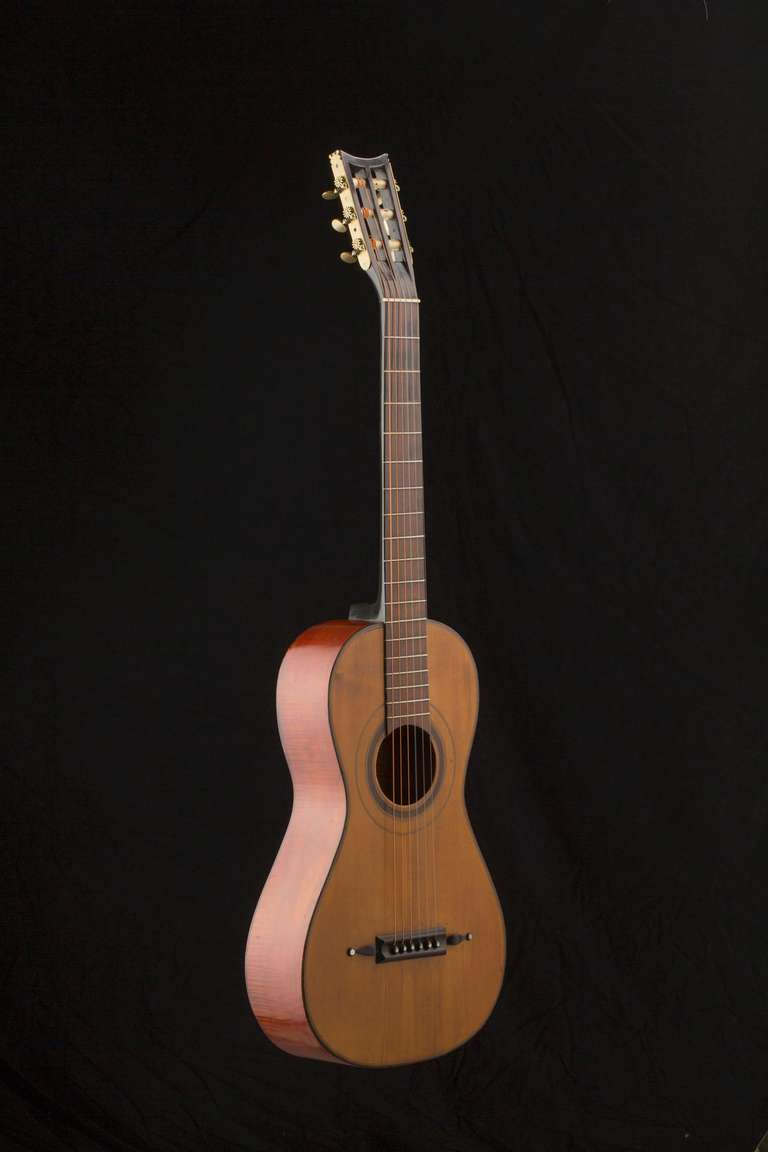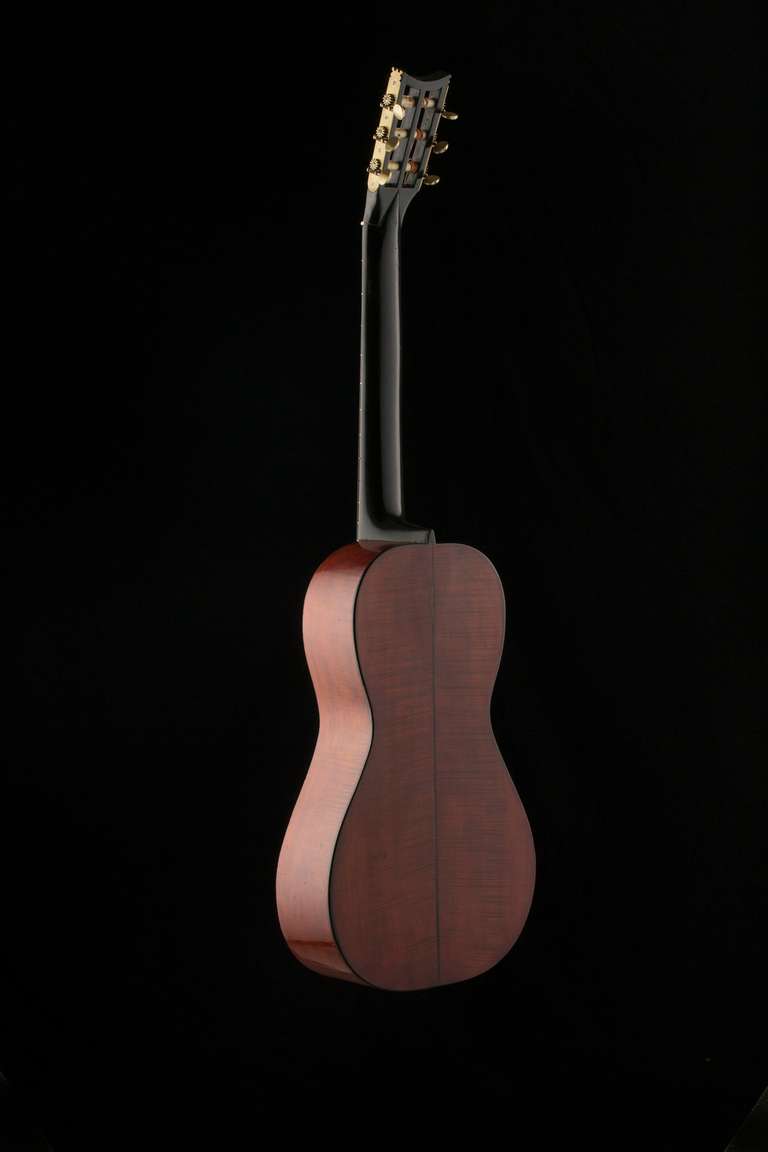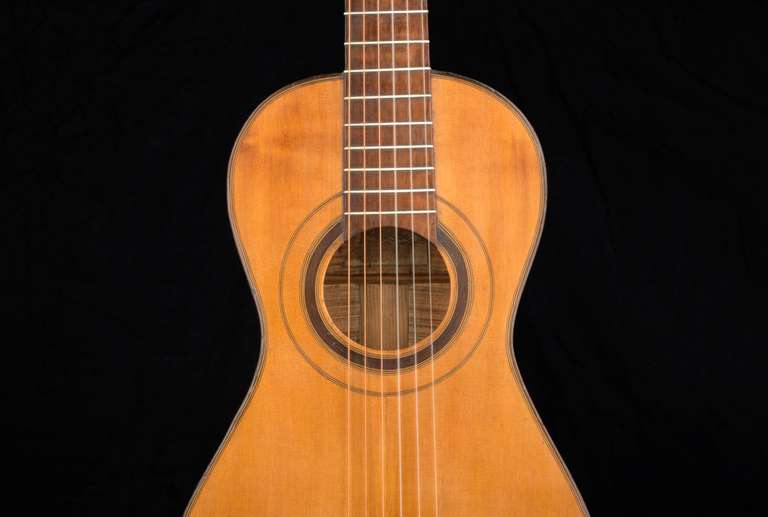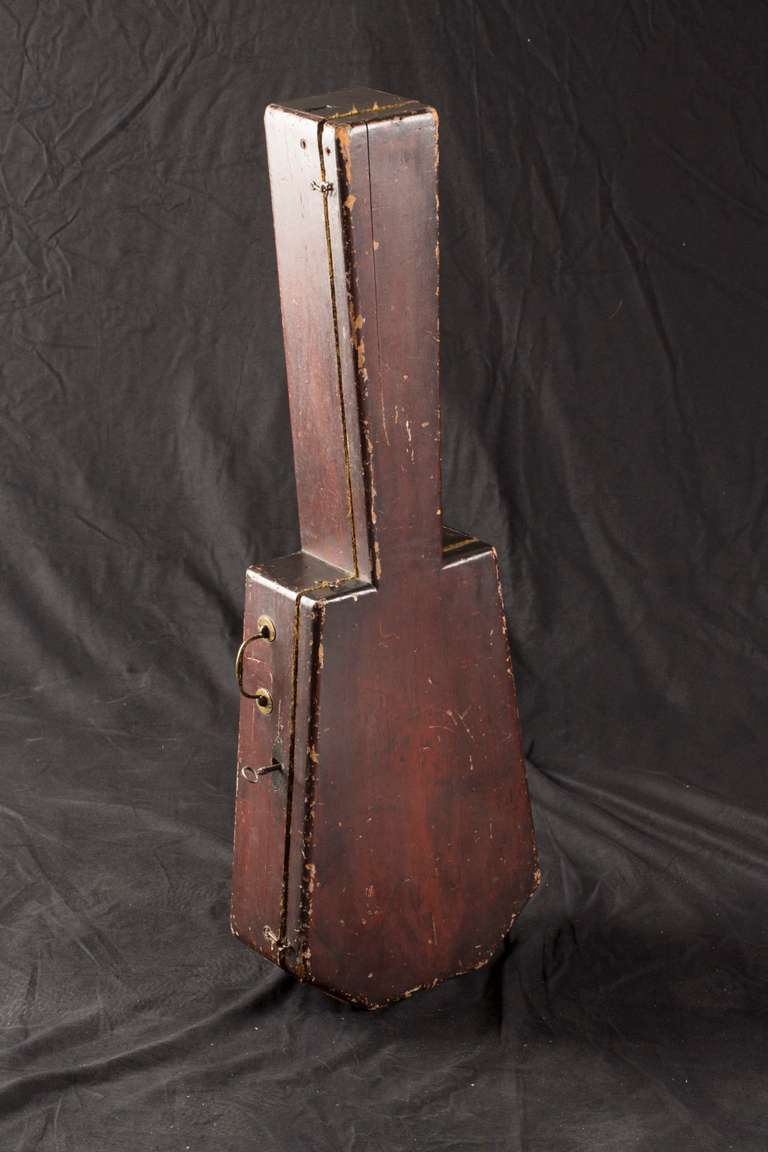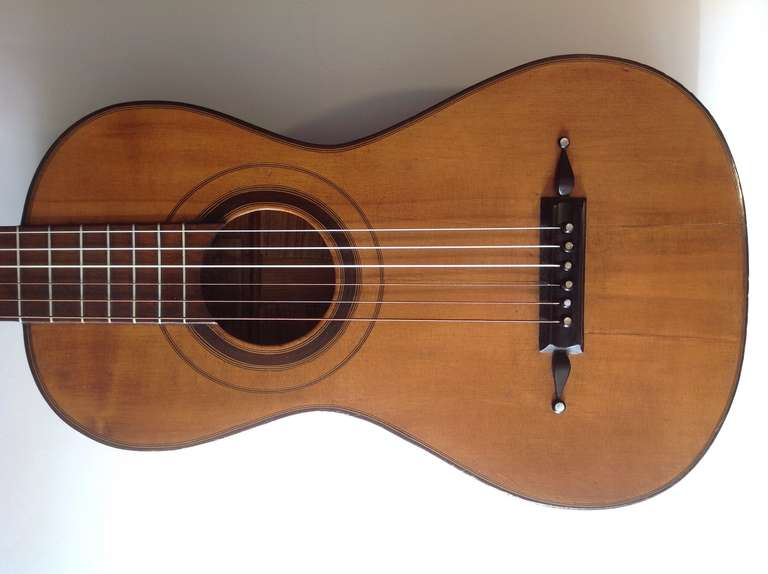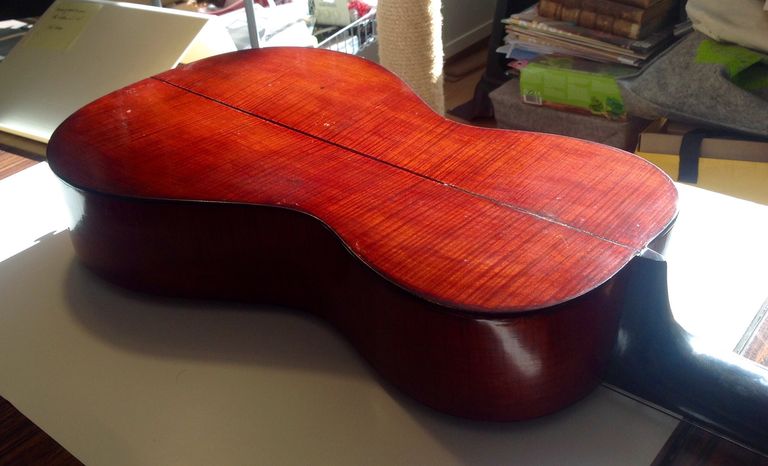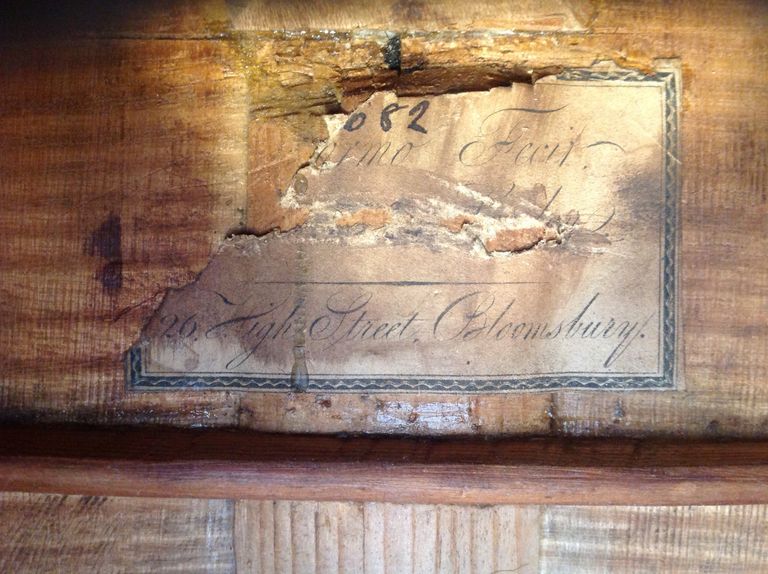Louis Panormo c. 1825

The guitar maker
Louis Panormo (1784~1862)
Born in Paris in 1784 Louis is perhaps the most prestigious member of the Panormo family. Like his brothers Joseph and George he had started by working with his father. When they left Paris Louis would have only been about five years old so apart from the influences he received from his father and elder brothers (those of Italian and French craftsmanship) he perhaps would have picked up more English influences than the others, as that is where he developed. In fact Louis became a British subject and seen in the 1851 census report on him. Louis, along with his brothers, set up shop at 23, High Street, Bloomsbury sometime in 1817, what had happened between their father's death in 1813 and this date remains unknown at this time. By 1822 they are first entered in Pigot's London Trade Directory, a year later Joseph had left for his own shop in nearby Soho. In 1826 it ceased to be listed as “Panormo and Co.” but under Louis own name, here he was listed still as only a violin maker, as had all the family. In 1829 Louis moved to 46, High Street, St. Giles (Bloomsbury) just a few doors along, now however he became known as a “guitar manufacturer” in the London Trade Directories. Business obviously developed nicely for Louis he received patronage from the rich society world and his prices became extravagantly high. In 1837 Louis resurrected Panormo and Company and set up a music selling and publishing business at 6, Greek Street Soho; while still keeping the guitar going at the High Street.
This high spot in his business career lasted four years, but in 1841 the premises at Greek Street had to go leaving Louis guitar making and music selling at 43 High Street. Perhaps the overheads of two places were too much for him after a while, or the business went through a slump. This situation lasted until 1847 when he added another workshop, the “Post Office” Trade Directory reads:
Panormo Louis Guitar Maker and Music Seller
43, High Street, St. Giles.
Panormo Louis Guitar Manufacturer
22, Compton Street, Brunswick Square
This was short lived (hence the variety of guitars from Compton Street) and by the next year he had moved into the one place at 31, High Street, St. Giles. Here Louis remained until 1854, when he emigrated to New Zealand.
Louis had a large family to maintain, there was his wife Sarah, a Bloomsbury girl born in 1801, at least three daughters, Elizabeth, Sophia and Cecilia, and four sons Vincentio, Charles, Theophilas and Frederick. There may have been more but these are the only ones found in the 1851 census report, but as Louis was already 57 years old at the first census in 1841 some children may have already left home by then. Frederick died as a baby (aged only three) the other sons would have helped in the workshop when old enough as it was very much a family concern. Unfortunately though, none of Louis's sons went on to make instruments like their father and fall into obscurity.
Bone in his book “The Guitar and Mandolin” tells us a story about another of Louis's daughters, Angiolina, who, he tells us, married the celebrated guitarist Huerta. Also that Huerta's favourite guitar was made by Louis and that Louis had published some music Huerta had dedicated to Angiolina. This story has yet to be authenticated, although I have seen a piece of music arranged for guitar by Madame Huerta. Sophia and Elizabeth did not marry however and both died in their twenties, it was after Elizabeth died in September 1854 that Louis emigrated to Auckland, New Zealand with whatever was left of his family. Why at the age of seventy Louis should want to make such a move remains a mystery, perhaps he wanted to give the remainder of his children a fresh start in a prosperous new land. His profession on his death certificate reads “Musical Instrument Maker” and as he lived out there for eight years some examples of his work must survive over in New Zealand somewhere. Louis Panormo died aged seventy eight on the 11 August 1862 in Awitu Block, Auckland, New Zealand, cause of death “Old Age”.
Louis was an outstanding guitar maker, amongst the finest in the history of the guitar and his output was tremendous as today many of his guitars can still be found. His guitars sold from two to fifteen guineas, as it says on his label, many of these were expensive guitars for the society world to which he gave much adornment, particularly in his elaborate use of Mother of Pearl. Also many serious Players and professional performers used his guitars and still do today, which is the greatest tribute anyone can give to Louis Panormo.
Description
This guitar is an early example of the works by Louis Panormo. Made in his first workshop at 26 High Street, Bloomsbury c. 1825. This guitar is a "French" model with maple back and sides, without pearl inlay.
The top is made of spruce, fine grained, with a thickness of 2,5 mm in the middle and 2,3 mm to the sides. A double rosette of concentric circles in veneers is inlayed around the soundhole. This is reflected by the bands of veneer on the edge of the corpus. (these go all the way through the soundboard and can clearly been seen between the tentellones on the inside)
An ebony pin bridge, in the typical Panormo style is on top of the soundboard. There is no saddle on these bridges, and the action has to be adjusted by reshaping the bridge. It couldn't be distinguished whether the two 'moustaches' are attached to the bridge or seperate pieces. Panormo used both varieties. On the ends are two ebony eyes with pearl inlay. The top is slightly domed, to which the underside of the bridge was shaped. The doming stops at the harmonic bar under the soundhole, which is straight.
On the inside of the top we find the ladder bracing, two horizontal spruce bars on both sides of the soundhole. Between the lower bar and the bridge is another one, slanted in a 20 degree angle from perpendicular to the centreline. Under the rosette , between both upper harmonic bars, are two reinforcement strips, made of mahogany. Glued to the sides of the guitar we find the bar supports. The top is secured to the sides with little glue blocks (tentellones) of quite irregular size, set at small intervals. This suggests a 'spanish' building method, using a solera. Here we also find the heavily damaged label on the inside of the back. Beside a repair label of the London workshops of Clifford Essex, dated August 1955. Placed over the spruce reinforcement plate between the upper harmonic bar and the neck.
The back (~ 2,5 mm) and sides (~ 1,5 mm - 1,8 mm) are made of flamed maple. An ebony strip is inlayed between the book matched plates of the back, reinforced on the inside by a wide spruce strip. There are three narrow bars to the back. It appears the back is mostly arched in the width and only slightly in the length of the corpus. It's secured to the sides by spruce linings. All bars of the guitar are flat sawn, a curious feature we normally find in lutes and earlier (baroque) guitars. On the lower block, at the join of the sides, we also find an ebony inlay.
The neck has a so-called 'Spanish slipper' or 'Spanish foot' on the inside of the guitar. It's made of stacked pieces of mahogany and painted black on the outside.
The headstock is attached with a narrow v-joint. It's shaped and slotted in the typical Panormo fashion, although it looks a bit 'lighter' and more open than later headstocks. The rosewood veneer might indicate that the guitar was originally made with wooden tuning pegs, but very soon after converted to use mechanical tuners. Despite their old age, the tuners turn very light and precise. Even better than most modern, factory made models. Because the tuners are not engraved and have simple brass nobs, rather than the famous ivory kidney buttons, they look a bit more modern to our eyes. They were almost certainly made by Rance, around 1823-25. Baker wouldn't start the production of the famous tuners until 1831. The worm-gear is placed at the lower side of the head. It can be hard to find tuners in this fashion these days.
A fingerboard of Brazilian Rosewood (Dalbergia Nigra) tops the neck. There are 3 little holes, two at the nut and one at the 12th fret, used to align the board during the glue process. There is a slight radius on the fingerboard. Panormo guitars usualy have a radius between 28" and 30". It's ivory frets are probably original. Despite a little wear they are in great shape, now have a height of 0,75 mm, which gives a very comfortable feel. Originally they must have been about 1 mm high.
The guitar is covered with a slightly reddish varnish. We do not know whether this is original or a later refinish. Most 'Panormo Fecit' guitars seem to have a clear yellowish finish. Examination under UV light didn't uncover more information.
The label inside of the guitar has suffered heavy damage. Year of manufacture has been obscured, but the serial number (682) is still visible which indicates 1825. The serial number doesn't represent the number of instruments made by the firm. Every year the first number changes, starting with the 400's in 1823.
Case
We don't know whether they made their own cases or bougth them from a seperate supplier.
Although a bit battered it is in a fairly original state. The case is made from softwood: pine or spruce. Painted brown on the outside (perhaps originally black ?). On the inside it is lined with a rough green felt on a burlap backing. The shape of the guitar is accomodated by two inserts of wood and paper, following the waste of the instrument. Under the neck we find a small compartment for strings and accessories. Its lid is helt on and hinging by a flap of lining.
The lid is helt on by two iron hooks and brass hinges. A small chest lock is used to keep the guitar safe from unauthorised hands. Unfortunately the lock plate is missing, but its shape could be reconstructed from indentations in the wood and paint finish. The handle is made of brass, a rather small and elegant form.
The wooden plates are glued together. A couple of little nails used to secure the parts together during the glue process.
The case is comfortably light, even when the guitar is inside. Despite its age it still does a great job of protecting the instrument.
Bracing
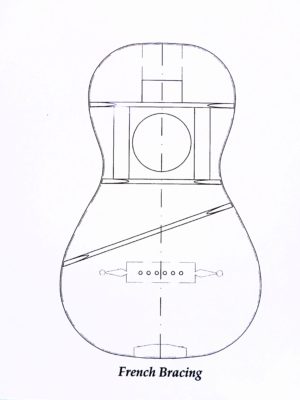
| Origin: | London |
| Scale: | 632 |
| Top: | Spruce |
| Back & Sides: | Maple |
| Tuners: | Original Rance tuning machines |

